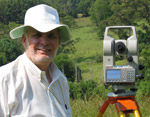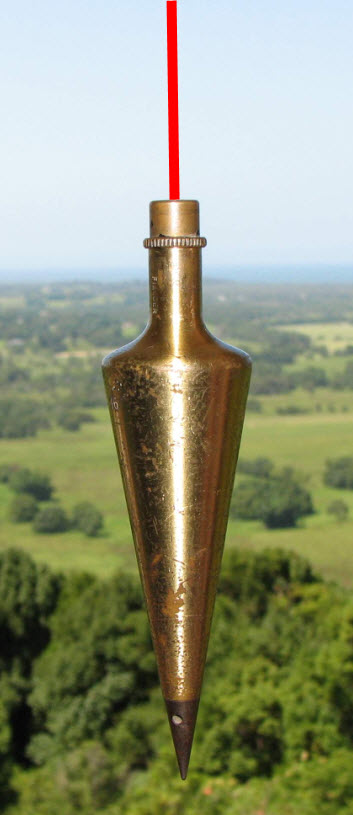Land boundary dispute resolution within the NSW Byron Shire. The unmaking of adjoining neighbours’ demarcation myths.
Folktales about plowmen who encroach upon their neighbours’ fields ~ ” Before the permanent allotment of lands, to every peasant, in sowing time, so much of the field or mark was assigned as was just and appropriate, and boundary posts were driven between his and his neighbour’s allotment. Whoever removed such marks, though he might escape punishment in this world, could find no rest in the grave, but by way of penalty must plough every night on the spot where his sin lay hidden.” Dishonest Plowman Legends , D. L. Ashliman
As a NSW Registered Land Surveyor working in the Mullumbimby, Byron Bay and Bangalow localities, I occasionally receive enquiries from distressed property owners concerning, from their perspective, supposed land boundary disputes with their adjoining neighbours. In this article I will attempt to clarify key relevant issues and highlight perceived property owner misconceptions. Water boundaries are excluded in this review.
Contrasts in the ownership of land experience can vary from ” Bliss “, as shown in the Windows XP, icon “Bliss” cartoon image above ~ to the unwelcome personal confrontation of a perceived land border, demarcation, land boundary dispute ~ being contentions between adjoining property owners, attempting to protect their own interests. Their perceptions are based sometimes on doubtful evidence, which requires factual land survey investigation.
How land boundaries are created in the first instance and associated responsibilities
In the State of NSW, land boundary rules of law are created by the Parliament, administered by the Government and interpreted by the Judiciary. In a worst case scenario, the absolute final arbitrator of the location of a land boundary on the ground is a Court of Law. The NSW Registered Land Surveyor is specially qualified, trained and has authorised competence in dealing with and resolving most land boundary issues.
The boundary limits of land ownership are accurately quantified in the quaintly termed ” title diagram “, as specified in the Certificate of Title (CT) of the individual land parcel. Currently, this diagram is actually a precisely surveyed and carefully prepared plan of land survey, referred to as a Deposited Plan of Survey ( DP ), and meeting the strict requirements of the Surveying and Spatial Information Act 2002 ~ Surveying and Spatial Information Regulation 2006 – ( 2012 from 1 September ), and the Registrar General’s Directions, NSW Land & Property Information ( LPI ).
Lodged DPs for the creation and subsequent reinstatement of land boundaries, are required to be accompanied by an extensive Checklist meeting statutory requirements, and signed off by the Registered Land Surveyor undertaking the boundary survey.
Delineated land boundaries are shown in the DP with accompanying corner reference marking details and State control surveyed connections for the future purpose of boundary reinstatement, if required.
The Registered Surveyor responsible for the surveyed DP, makes a mandatory legal declaration in the Survey Certificate panel contained within the separate DP Administration Sheet, stating that the survey was carried out in accordance with the statutory regulations. There is no provision within this Survey Certificate, see above, for boundary survey work to be undertaken ” under supervision “. The NSW Board of Surveying and Spatial Information ( BOSSI ) issues a photograph identification card to Registered Land Surveyors, for the authorisation of entry to land for survey purposes.
In modern land survey practice, the land boundary dispute description statement is usually a misnomer
The established doctrine of indefeasibility applicable to Torrens title land, refers to the State guarantee as to certainty of ownership of land, inclusive of land boundaries. In the case of Limited Title, land boundaries are not guaranteed.
In my view, modern NSW land boundaries can be construed as land boundaries created since the introduction of precision electronic distance measurement for cadastral surveys in the early 1970s. Additionally, from this period onwards, NSW survey regulations provided for improved reference marking and survey control connection to selected land boundary corners in the DP. This improved technology, with better survey monumentation, resulted in the accurate reinstatement of land boundaries, when required.
Simply put, with modern land boundary surveys, there is usually no doubt as to where a title boundary is on the ground. Depending on local circumstances, more office investigation and field work may be required to reinstate a particular land boundary correctly in its original position, especially where original survey monuments are gone.
Accordingly, the description that ” an issue is a land boundary dispute “, is a misnomer. With modern boundary surveys, the validity of a correctly reinstated land boundary on the ground, can be considered not to be in contention. The ground land boundary location generally cannot be disputed, but rather the real issue being, contentions between adjoining neighbours regarding structures and/or vegetation, related to the correctly determined and known ground boundary position.
Separating the fundamental issues of contention and dispute
The ground location for a particular land boundary may not be known by adjoining land owners for a variety of reasons. Original ground surface statutory survey pegs are gone as a result of construction, utility services, land clearing, agricultural activity, garden creation, invasive vegetation, fence erection, storm and weather impact, and deterioration through age. Additionally, in my local experience, it is not unknown for statutory survey pegs to be deliberately removed and/or repositioned incorrectly.
The primary and first process to resolve a contentious boundary location, is to have that boundary correctly reinstated and marked on the ground by a Registered Land Surveyor. If necessary, the surveyed identification of adjoining building structures, fences, vegetation and trees, related to that boundary, may also be undertaken. In this survey task a detailed written report and plan of survey is also supplied by the Registered Land Surveyor, which may be useful in ongoing negotiations.
Once the correct ground boundary is known with certainty, with accompanying supporting documentation, potentially as admissible evidence, then neighbour issues related to that boundary can be addressed.
Further options for consideration for more complex, contentious land boundaries
The Registered Land Surveyor to lodge a formal deposited plan of survey ( DP ), known as a redefinition plan, detailing the boundary reinstatement for the land boundary in contention. This plan is examined, registered as a DP by the NSW Registrar General and is available in the public domain. No Local Government certificate is required for this type of lodged survey plan.
As evidenced by a recent Court report concerning a retaining wall feud along a common boundary, litigation fees can escalate to an excessive amount. In order to provide an alternative process to possible expensive legal and court costs, the NSW Registrar General, under Part 14A Real Property Act 1900, may through an application for boundary determination and payment of associated fees, undertake an examination survey to resolve a more complex boundary dispute, particularly in regard to older created land boundaries.
Land owners’ possible misconceptions relevant to a contentious land boundary
To establish with certainty that a corner post or line fencing is correctly located on a land boundary, requires that investigation and a check survey be undertaken by a Registered Land Surveyor. This check survey will confirm whether the relevant land boundary passes through the material of fencing, or not. In my local experience, it is not unknown for rural perimeter boundary and corner fencing to be erected up to several metres from the correct boundary position, sometimes resulting in adjoining neighbours adopting an incorrect presumption.
Online aerial imagery or aerial mapping supplied by Local Government, showing a cadastral or land boundary overlay, should be treated with caution. Land boundaries shown in this media are not survey accurate and cannot be relied upon to establish or interpret a land boundary position correctly. At best, boundary lines shown should be considered as diagrammatic only. There are too many instances, where boundaries shown within the imagery, are wrongly displaced many metres from the real road and land parcel boundary location, and not correctly related to displayed infrastructure.
In the disclaimer noted below, with respect to mapping, aerial imagery, and associated displayed land boundaries, Byron Shire Council states no warranty is given, that the issued map provided, is free from error or omission.
In common land law, the most weight is given to boundary evidence on the ground.
Impacts on a land boundary, which may lead to neighbour contention
Post resolution of the correct ground boundary location, in my experience the type of issues contested with respect to a common boundary, are not limited to the following -
- Erected fence lines and retaining walls.
- Building structures, walls and attachments, and foundation support.
- Vegetation, trees and branches.
- Legal access to a land parcel.
- The proper use of land.
- The entering of a neighbour’s land without consent, possibly leading to trespass.
Within their land parcel boundaries, the property owner(s) has the right to fully enjoy their own amenity through the use, care, control and management of their property, being in compliance with Local Government land use laws.
Should you have any enquiries concerning land boundary issues related to this article in the Byron, Bangalow and Mullumbimby localities, I offer as an experienced New South Wales Registered Land Surveyor, personal professional service and expert friendly advice, leading to successful client outcomes.
NEW SOUTH WALES NORTHERN RIVERS REGION - AUSTRALIA
BYRON BAY – BANGALOW – MULLUMBIMBY – BRUNSWICK HEADS – WATEGOS BEACH – ST. HELENA – OCEAN SHORES – SUFFOLK PARK – FEDERAL – WILSONS CREEK – BALLINA – LISMORE – TWEED HEADS – MURWILLUMBAH – LENNOX HEAD – TINTENBAR – CLUNES – BEXHILL – COORABELL – POSSUM CREEK – MYOCUM – EWINGSDALE – WANGANUI – GOONENGERRY – COOPERS SHOOT – EUREKA – MAIN ARM – CRABBES CREEK – YELGUN – CASINO – NIMBIN – BURRINGBAR – UKI – BILLINUDGEL – POTTSVILLE – WOLLONGBAR – ALSTONVILLE – MOOBALL – KYOGLE – HUONBROOK – NASHUA
Please visit my website for contact details.
An explanation of the above land related terminology, may be found in a glossary provided by the New South Wales Land and Property Information ( NSW LPI ), Registrar General’s Directions.
..










